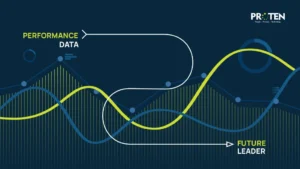Previously, we laid the foundation for succession planning and established why it is important for you to do it, starting with the intriguing story surrounding an iconic fashion brand. In case you need a refresher, succession planning is a process used to identify, develop, and prepare employees to take on critical roles in your company when current jobholders leave or retire. It’s about ensuring business continuity by having qualified individuals ready to enter key positions.
Succession planning is important because it ensures your day-to-day activities aren’t put on hold. It’s also a way to increase your employees’ motivation. To learn more about how this process works and explore its other advantages, you can check it out here.
We also simplified the process of succession planning. That is, what you have to do to ensure the process runs smoothly. And because we want you to have an intricate understanding of the process, we will cover it here. By learning these steps, you can be sure to carry out succession planning in the most stress less way possible.
What Are The Steps In Succession Planning?
The process of succession planning can be divided into five simple steps. Role identification, talent assessment, development planning, succession charting, and risk assessment. We’ll explore them below:
1. Role Identification.
Role identification is the first step to take in succession planning. It involves a detailed analysis of each critical role within an organization to determine its specific responsibilities, required skills, and necessary qualifications. To put it in simpler terms, you’re figuring out the kind of person you need. Let’s look back to the example of the marketing team given in our previous article.
So the marketing lead is getting ready to leave, and someone is needed to replace them. You’ll want someone who is strategic and knows how to reach your target audience and generate leads. Someone whose qualities align with the role. So now that you’ve identified the qualities you want said successor to possess, you can begin to scan through the team for the nearest person bearing those qualities—someone who already knows the job.
This process helps to identify the unique attributes and competencies needed to effectively fill these roles. By understanding the specific demands of each position, you can develop targeted succession strategies to ensure a smooth leadership transition when vacancies arise.
Remember that you aim to ensure continuity, and this is easily attained when there is an alignment between the role and the qualities of the role’s successor. Additionally, you can prevent the risk of bringing in someone who is not familiar enough with the ‘how-about’ of the role.
2. Talent Assessment.
This is the component of succession planning that involves evaluating individuals’ skills, abilities, and potential to determine their suitability for future leadership roles. You could even call it an audition.
This process typically includes a combination of methods such as performance reviews, assessments, interviews, and behavioral observations. By assessing individuals’ strengths, weaknesses, and development needs, you can identify high-potential candidates and tailor their development plans accordingly.
Talent assessment helps to ensure that your company has a stash of qualified individuals who are ready to step into key positions when vacancies arise, thereby mitigating risks associated with leadership turnover and promoting organizational continuity.
3. Development Planning.
Remember those predictable story plots where an elder scouts seven lands for the chosen one, and when the chosen one is found in the most comical way possible, they have to train to take up the role of the special leader?
Development planning is exactly like that.
Development planning in succession planning involves identifying and preparing individuals within an organization to fill key positions as they become available. This process includes creating tailored development action plans for high-performing employees, ensuring they gain the necessary skills and experience to effectively step into critical roles.
It’s essential to focus on nurturing talent and providing career growth opportunities to maintain organizational continuity.
4. Succession Charting.
Charts and graphs are the ways to go with this component of succession planning. Here, you make a visual representation of the potential paths your employees can take to fill critical roles within an organization.
It’s a key tool in succession planning, which aims to identify and develop high-potential individuals to fill future leadership positions. Succession charts typically include key positions, which are critical roles that are essential to your company’s success.
These positions are often those that have a significant impact on your organization’s strategy, operations, or financial performance.
In addition to key positions, succession charts also include potential successors. These are employees who have the potential to fill these positions. They are typically identified based on their skills, experience, and performance.
To ensure that potential successors are ready to take on leadership roles, succession charts also include development needs. These are the skills and knowledge that potential successors need to acquire to be effective in the roles. Development needs may include technical skills, leadership skills, or industry-specific knowledge.
Finally, succession charts often include timelines. These are the estimated timeframe for succession planning and development. Timelines help organizations track progress and ensure that they are on track to fill critical positions when vacancies arise.
5. Risk Assessment.
Risk assessment is the process of identifying and evaluating potential risks that could hinder your company’s ability to fill critical roles. It’s a crucial step in ensuring your succession plan is robust and effective.
One of the primary risks to consider is talent shortages. This can occur due to factors such as retirement, resignations, or a lack of qualified candidates. If you want to avoid this, you need to have a robust talent acquisition strategy and invest in employee development.
Another risk is office politics. If there is significant internal competition for leadership positions, it can create challenges in identifying and developing potential successors. To address this risk, you need to foster a culture of collaboration and transparency.
External factors such as economic downturns, industry changes, or global events can also pose risks to succession planning. You should monitor the external environment and be prepared to adjust their succession plans as needed.
By conducting a thorough risk assessment, you can identify potential obstacles to their succession planning efforts and develop strategies to mitigate them. This helps to ensure that the organization has a sustainable pipeline of talent and is well-prepared to fill critical roles in the future.
In Conclusion…
Succession planning, a proactive strategy that ensures you have a pipeline of talented individuals ready to assume leadership roles, is more than just a transactional process; it’s a strategic investment in the future of the organization.
By identifying key positions, assessing potential successors, developing personalized plans, and monitoring progress, you can avoid risks, foster a culture of internal mobility, and sustain their long-term success.
A well-executed succession plan goes beyond simply filling vacancies. It ensures that you have a pool of qualified individuals who are aligned with its strategic goals, possess the necessary skills and knowledge, and are ready to take on leadership responsibilities when the time comes.
This not only helps to maintain continuity and minimize disruptions but also sends a powerful message to your employees about your commitment to their development and career growth. Moreover, succession planning can foster a culture of internal mobility, which can lead to increased employee engagement, reduced turnover, and improved morale.
When employees see opportunities for advancement within the organization, they are more likely to be motivated and committed to their work.
In conclusion, succession planning is a critical component of effective organizational management. By investing in the development of their future leaders, you can build a strong foundation for continued success and ensure that they are well-positioned to navigate the challenges and opportunities of the future.










